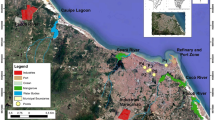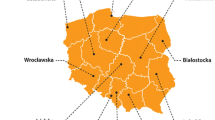Abstract
Semi-volatile organic pollutants (SVOCs) have a recognized impact on the environment and some of them have been banned in many countries for that reason. Others are not regulated in air quality legislation, except for benzo(a)pyrene (BaP), a polyaromatic hydrocarbon resulting from natural and anthropogenic combustion processes. The EU set an annual average limit of 1 ng/m3 in air and some health parameters can also be inferred from the correspondent ecotoxicity thresholds established for this chemical. With the help of chemistry transport models, the evolution of these parameters can be assessed under climate change scenarios, along with the BaP concentrations themselves. Hence, a scenario with MM5-CHIMERE driven by ECHAM5 SRES A2 forcing were calculated for the years 1991 to 2050, in a European domain with a spatial resolution of 25 km. An enhanced risk of lung cancer was registered throughout the covered area, deriving from a parallel increase in the BaP levels in air.
Access provided by Autonomous University of Puebla. Download conference paper PDF
Similar content being viewed by others
Keywords
These keywords were added by machine and not by the authors. This process is experimental and the keywords may be updated as the learning algorithm improves.
1 Introduction
Polycyclic aromatic hydrocarbons (PAHs) are widespread chemicals of concern due to their carcinogenicity and mutagenic properties (IARC 2010). Plus, having high lipid solubility, they are absorbed in the lung tissue, skin, breast or intestines, which raises the potential risk of affecting human health (Kim et al. 2013). With these evidences, monitoring programs and modelling strategies are needed to better evaluate their presence and fate over a large geographical area to help decision-making on their impacts in the future. PAHs are released into the environment via many natural and anthropogenic sources and can be found in either gas or particulate phase in the atmosphere (Ramírez et al. 2011). Almost entirely in particulate-bound material, benzo(a)pyrene (BaP) is the only PAH with a legal limit set by the European Union (Directive 2004/107/EC, amended by Regulation 219/2009) for air: 1 ng/m3 as mean for a year on PM10. As we are dealing with hazardous substances, it is also important to consider health issues and some guidelines have been presented in literature to characterize their harmful potential (Butterfield and Brown 2012). The impact of climate change on air quality is a crucial topic (Jiménez-Guerrero et al. 2013) and can also play a decisive part on the expression of these parameters, yet need downscaled scenarios, with the highest spatial resolution possible. The aim of this work is thus to evaluate the impact of climate change on future levels of benzo[a]pyrene over Europe until 2050 under the A2 SRES scenario.
2 Experimental
The regional modelling set-up used in this study consists of a coupling between a climatic version of the MM5 model and CHIMERE chemistry transport model, on a domain covering most of Europe with a spatial resolutions of 25 km and 24 sigma levels are in the vertical, up to 100 hPa. The regional climate simulations driving the CTM were performed using the regional climate model MM5 driven by the European Centre/Hamburg 5-Run1 simulation forced by the SRES-A2 scenario, which lies towards the upper end of the IPCC emission range. Further details on the regional climate simulations and the validation of the present-day simulations can be found in Jerez et al. (2013). In the current study, simulations cover the period from 1991 to 2050. Simulations for present-day climatologies (1991–2010) have been compared to a time slice covering 2031–2050. In order to isolate the possible effects of climate change on the ground concentrations of air pollution, unchanged anthropogenic emissions derived from the European Monitoring and Evaluation Programme (EMEP) database are considered not accounting for possible changes on vegetation, land use, anthropogenic pollutant emission changes or any feedbacks from the chemical compounds to the meteorological fields, but allowing changes in natural emissions.
3 Results and Discussion
Results reveal that the modelled BaP concentrations for the 1991–2010 period exceed 0.1 ng m−3 as annual averages in some areas in Europe, namely Portugal, Spain, Netherlands, Germany or Italy, and rising above 0.5 ng m−3 over parts of Poland. Overall, and as expected, the highest modelled levels are found where most anthropogenic sources like traffic, building heating or industrial combustion occur, that is, in urban (e.g. Lisbon, Portugal) and industrial locations (Ruhr area, Germany). The concentrations obtained for the 2031–2050 period under the SRES A2 scenario show the highest increases over western France (up to 25 %), an area with a very low current BaP incidence (Fig. 21.1, top). In the areas with the highest BaP presence (for instance, eastern Europe and western Iberia), there are projections of a about 15 % increases. The general decay of precipitation modelled for future climates (e.g. Jiménez-Guerrero et al. 2013) suggest less wet deposition of BaP and the consequent increase of its air concentration. As an example of the health parameters available for BaP, we selected the increased risk of lung cancer due to industrial exposure to PAHs. The European Union calculated the increased risk for three possible target values: 0.01 ng m−3 with an associated increased risk of 1 × 10−6; 0.1 ng m−3 (increased risk of 1 × 10−5); and 1 ng m−3 (increased risk of 1 × 10−4). Being the last value the EU limit for the annual mean concentration of BaP (1 ng m−3), the upper limit of the additional life-time risk should be below 1 × 10−4 (Butterfield and Brown 2012). Considering the present-day scenario, this target is only exceeded in Ukraine. However, as seen in Fig. 21.1 (bottom), for SRES A2-driven projections, the risks of lung cancer escalate noticeably all over Europe. Although the 1 ng m−3 target value is still only exceeded in Ukraine, a greatly larger area in Europe surpasses the 0.1 ng m−3 mark, such as over the Ruhr Valley in Germany or the Netherlands. In view if these findings it can be stated that the general increased risk of lung cancer over Europe (1 × 10−6 for the present scenario) becomes an order of magnitude higher (1 × 10−5).
(Top, left) Present day mean concentrations of BaP over Europe (1991–2010) (pg m−3) and (top, right) percentual increase in the levels of this compound for the 2031–2050 period under the SRES A2 scenario compared to present-day levels. (Bottom) Exceedances of the possible target values (shaded, ng m−3) and associated increased risk of lung cancer, life-time exposure to the target value (contours), as defined by the Quantitative Risk Assessment included in Butterfield and Brown (2012). (Bottom, left) Present-day conditions; (bottom, right) SRES A2 scenario
4 Conclusions
The regional climate modelling coupling (MM5-RCM and CHIMERE) used in simulations comprising present conditions (1991–2010) and the future SRES A2 scenario (2031–2050) show the plausible influence of climate change on the atmospheric concentrations of BaP and on the increased risk of lung cancer over Europe. For BaP incidence, the A2 scenario revealed a projection of regional increase in the levels up to 25 % in some areas and about 15 % in a vast portion of the domain. In terms of health indicators, the general increased risk of lung cancer in Europe becomes an order of magnitude higher under the A2 scenario: 1 × 10−5 versus 1 × 10−6 for the present scenario.
References
Butterfield DM, Brown RJC (2012) Polycyclic aromatic hydrocarbons in Northern Ireland. National Physical Laboratory Report AS66, Teddington, Middlesex, UK, 86 pp
IARC (2010) Monographs on the evaluation of carcinogenic risks to humans—some non-heterocyclic polycyclic aromatic hydrocarbons and some related exposures, vol. 92. Lyon-France, 858 pp
Jerez S, Jiménez-Guerrero P, Montávez JP, Trigo RM (2013) Impact of the North Atlantic Oscillation on European aerosol ground levels through local processes: a seasonal model-based assessment using fixed anthropogenic emissions. Atmos Chem Phys 13:11195–11207
Jiménez-Guerrero P, Gómez-Navarro JJ, Baró R, Lorente R, Ratola N, Montávez JP (2013) Is there a common pattern of future gas-phase air pollution in Europe under diverse climate change scenarios? Clim Change 121:661–671
Kim K-H, Jahan SA, Kabir E, Brown RJC (2013) A review of airborne polycyclic aromatic hydrocarbons (PAHs) and their human health effects. Environ Int 60:71–80
Ramírez N, Cuadras A, Rovira E, Marcé RM, Borrull F (2011) Risk assessment related to atmospheric polycyclic aromatic hydrocarbons in gas and particle phases near industrial sites. Environ Health Perspect 119:1110–1116
Acknowledgments
This work was partially funded by the European Union Seventh Framework Programme-Marie Curie COFUND (FP7/2007–2013) under UMU Incoming Mobility Programme ACTion (U-IMPACT) Grant Agreement 267143. The Spanish Ministry of Economy and FEDER (project DIDIER CGL2013-48491-R) are acknowledged for their partial funded. Dr. Pedro Jiménez-Guerrero acknowledges the Ramón y Cajal programme.
Author information
Authors and Affiliations
Corresponding author
Editor information
Editors and Affiliations
Question and Answer
Question and Answer
QUESTIONER: Jaakko Kukkonen
QUESTION: Small-scale combustion is also responsible for the emissions of BaP. These emissions will very likely increase in the future, caused by climate change reduction policies that favour the use of renewable energy. How is this projected increase of BaP emissions reflected in your results?
ANSWER: In the approach followed in this contribution, the main objective is to to isolate the possible effects of climate change on the ground concentrations of air pollution. Therefore, the hypothesis of unchanged anthropogenic emissions has been implemented in the simulations. Therefore, BaP emissions coming from anthropogenic combustion processes have been kept constant.
Rights and permissions
Copyright information
© 2016 Springer International Publishing Switzerland
About this paper
Cite this paper
Jiménez-Guerrero, P., Ratola, N. (2016). Health Parameters Under Climate Change Projections for Airborne Benzo[a]Pyrene. In: Steyn, D., Chaumerliac, N. (eds) Air Pollution Modeling and its Application XXIV. Springer Proceedings in Complexity. Springer, Cham. https://doi.org/10.1007/978-3-319-24478-5_21
Download citation
DOI: https://doi.org/10.1007/978-3-319-24478-5_21
Published:
Publisher Name: Springer, Cham
Print ISBN: 978-3-319-24476-1
Online ISBN: 978-3-319-24478-5
eBook Packages: Earth and Environmental ScienceEarth and Environmental Science (R0)





